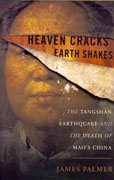Heaven Cracks, Earth Shakes
James Palmer
book reviews:
· general fiction
· chick lit/romance
· sci-fi/fantasy
· graphic novels
· nonfiction
· audio books
· author interviews
· children's books @
curledupkids.com
· DVD reviews @
curledupdvd.com
newsletter
win books
buy online
links
home
for authors
& publishers
for reviewers

 |
Heaven Cracks, Earth Shakes: The Tangshan Earthquake and the Death of Mao's China James Palmer Basic Books Hardcover 296 pages January 2012 |
|
The demise of the much-loved Chinese Prime Minister Zhou Enlai, the ruthless suppression of the many subsequent public demonstrations of affection for Zhou, a disastrous earthquake in the city of Tangshan, and the passing of Chairman Mao Zedong all occurred in 1976. There is no gainsaying the fact that this was a tumultuous year in modern Chinese history. It was also, from the perspective of many Chinese, a “cursed” year. Heaven Cracks, Earth Shakes
The events surrounding the funeral of Zhou Enlai are delineated in considerable detail. Although Mao himself had little regard for Zhou, the Prime Minister was much loved by many Chinese. While making this last point, the author helpfully demolishes a popular myth about the Chinese which holds that they are unusually docile and that “they easily accept oppression or are naturally willing to bow down to power” (p. 89). Chinese citizens have rebelled and revolted against all manner of officialdom throughout history. Even during the time of the so called Cultural Revolution, the Chinese went to great lengths to fight a system that many of them believed had more to do with the preservation of “ideological shibboleths” and less to do with “national well-being” (p. 99). One reason why the earthquake in Tangshan was cataclysmic is that there was insufficient preparation, even though the possibility of a major earthquake beneath the center of a major city such as Tangshan had been raised. When the earthquake did actually strike Tangshan, it is said to have released energy equal to 400 times the energy released by the atom bomb dropped on Hiroshima. This destroyed Tangshan and scarred its citizenry for many years. The response of the central authorities in Beijing to the vast human tragedy that had unfolded before them represented “panicked and inadequate planning and communication” (p. 159). This response also showed that while cities mattered, “the countryside simply didn’t matter to the central authorities” (p. 158). A key point made by the author is that this haphazard response of the central authorities combined with some of the other noteworthy events that transpired in 1976 proved to be inimical to the Cultural Revolution and to the vitality of Mao Zedong’s regime. Chairman Mao’s passing in September 1976 created a period of confusion in China, and the last part of this book documents this chaotic period, the activities of the so called “Gang of Four,” and the inexorable rise of Deng Xiaoping and a new order. Although this new order helped many Chinese in specific ways, it came with a clear bargain: “stay out of politics and you won’t get hurt” (p. 227). There are a few errors of commission—Maya Lin, the American designer of the Vietnam Memorial, is referred to as Chinese—and omission—there is insufficient explanation of why it was safest to be underground during the Tangshan earthquake—in this book. This notwithstanding, Heaven Cracks, Earth Shakes Originally published on Curled Up With A Good Book at www.curledup.com. © Amitrajeet A. Batabyal, 2013 |
|
|
|
 Click here to learn more about this month's sponsor! |
|
| fiction · sf/f · comic books · nonfiction · audio newsletter · free book contest · buy books online review index · links · · authors & publishers reviewers |
|
| site by ELBO Computing Resources, Inc. | |
 The intent of the so called “Great Leap Forward” from 1958 to 1961 was to transform Chinese agriculture and industry for the better. Instead, the outcome of this colossal misadventure was the loss of around fifty million lives due to famine and other related reasons.
The intent of the so called “Great Leap Forward” from 1958 to 1961 was to transform Chinese agriculture and industry for the better. Instead, the outcome of this colossal misadventure was the loss of around fifty million lives due to famine and other related reasons.